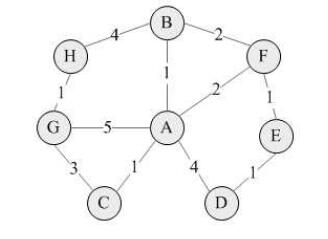任务描述:在一个无向图中,获取起始节点到所有其他节点的最短路径描述
dijkstra(迪杰斯特拉)算法是典型的最短路径路由算法,用于计算一个节点到其他所有节点的最短路径。主要特点是以起始点为中心向外层层扩展,直到扩展到终点为止。
dijkstra一般的表述通常有两种方式,一种用永久和临时标号方式,一种是用open, close表方式
用open,close表的方式,其采用的是贪心法的算法策略,大概过程如下:
1.声明两个集合,open和close,open用于存储未遍历的节点,close用来存储已遍历的节点
2.初始阶段,将初始节点放入close,其他所有节点放入open
3.以初始节点为中心向外一层层遍历,获取离指定节点最近的子节点放入close并从新计算路径,直至close包含所有子节点
代码实例如下:
node对象用于封装节点信息,包括名字和子节点
|
1
2
3
4
5
6
7
8
9
10
11
12
13
14
15
16
17
18
19
|
public class node { private string name; private map<node,integer> child=new hashmap<node,integer>(); public node(string name){ this.name=name; } public string getname() { return name; } public void setname(string name) { this.name = name; } public map<node, integer> getchild() { return child; } public void setchild(map<node, integer> child) { this.child = child; }} |
mapbuilder用于初始化数据源,返回图的起始节点
|
1
2
3
4
5
6
7
8
9
10
11
12
13
14
15
16
17
18
19
20
21
22
23
24
25
26
27
28
29
30
31
32
33
34
35
36
37
38
39
40
41
42
43
|
public class mapbuilder { public node build(set<node> open, set<node> close){ node nodea=new node("a"); node nodeb=new node("b"); node nodec=new node("c"); node noded=new node("d"); node nodee=new node("e"); node nodef=new node("f"); node nodeg=new node("g"); node nodeh=new node("h"); nodea.getchild().put(nodeb, 1); nodea.getchild().put(nodec, 1); nodea.getchild().put(noded, 4); nodea.getchild().put(nodeg, 5); nodea.getchild().put(nodef, 2); nodeb.getchild().put(nodea, 1); nodeb.getchild().put(nodef, 2); nodeb.getchild().put(nodeh, 4); nodec.getchild().put(nodea, 1); nodec.getchild().put(nodeg, 3); noded.getchild().put(nodea, 4); noded.getchild().put(nodee, 1); nodee.getchild().put(noded, 1); nodee.getchild().put(nodef, 1); nodef.getchild().put(nodee, 1); nodef.getchild().put(nodeb, 2); nodef.getchild().put(nodea, 2); nodeg.getchild().put(nodec, 3); nodeg.getchild().put(nodea, 5); nodeg.getchild().put(nodeh, 1); nodeh.getchild().put(nodeb, 4); nodeh.getchild().put(nodeg, 1); open.add(nodeb); open.add(nodec); open.add(noded); open.add(nodee); open.add(nodef); open.add(nodeg); open.add(nodeh); close.add(nodea); return nodea; }} |
图的结构如下图所示:

dijkstra对象用于计算起始节点到所有其他节点的最短路径
|
1
2
3
4
5
6
7
8
9
10
11
12
13
14
15
16
17
18
19
20
21
22
23
24
25
26
27
28
29
30
31
32
33
34
35
36
37
38
39
40
41
42
43
44
45
46
47
48
49
50
51
52
53
54
55
56
57
58
59
60
61
62
63
64
65
66
67
68
69
70
|
public class dijkstra { set<node> open=new hashset<node>(); set<node> close=new hashset<node>(); map<string,integer> path=new hashmap<string,integer>();//封装路径距离 map<string,string> pathinfo=new hashmap<string,string>();//封装路径信息 public node init(){ //初始路径,因没有a->e这条路径,所以path(e)设置为integer.max_value path.put("b", 1); pathinfo.put("b", "a->b"); path.put("c", 1); pathinfo.put("c", "a->c"); path.put("d", 4); pathinfo.put("d", "a->d"); path.put("e", integer.max_value); pathinfo.put("e", "a"); path.put("f", 2); pathinfo.put("f", "a->f"); path.put("g", 5); pathinfo.put("g", "a->g"); path.put("h", integer.max_value); pathinfo.put("h", "a"); //将初始节点放入close,其他节点放入open node start=new mapbuilder().build(open,close); return start; } public void computepath(node start){ node nearest=getshortestpath(start);//取距离start节点最近的子节点,放入close if(nearest==null){ return; } close.add(nearest); open.remove(nearest); map<node,integer> childs=nearest.getchild(); for(node child:childs.keyset()){ if(open.contains(child)){//如果子节点在open中 integer newcompute=path.get(nearest.getname())+childs.get(child); if(path.get(child.getname())>newcompute){//之前设置的距离大于新计算出来的距离 path.put(child.getname(), newcompute); pathinfo.put(child.getname(), pathinfo.get(nearest.getname())+"->"+child.getname()); } } } computepath(start);//重复执行自己,确保所有子节点被遍历 computepath(nearest);//向外一层层递归,直至所有顶点被遍历 } public void printpathinfo(){ set<map.entry<string, string>> pathinfos=pathinfo.entryset(); for(map.entry<string, string> pathinfo:pathinfos){ system.out.println(pathinfo.getkey()+":"+pathinfo.getvalue()); } } /** * 获取与node最近的子节点 */ private node getshortestpath(node node){ node res=null; int mindis=integer.max_value; map<node,integer> childs=node.getchild(); for(node child:childs.keyset()){ if(open.contains(child)){ int distance=childs.get(child); if(distance<mindis){ mindis=distance; res=child; } } } return res; }} |
main用于测试dijkstra对象
|
1
2
3
4
5
6
7
8
|
public class main { public static void main(string[] args) { dijkstra test=new dijkstra(); node start=test.init(); test.computepath(start); test.printpathinfo(); }} |
打印输出如下:
d:a->d
e:a->f->e
f:a->f
g:a->c->g
b:a->b
c:a->c
h:a->b->h
以上就是本文的全部内容,希望对大家的学习有所帮助,也希望大家多多支持服务器之家。
原文链接:https://blog.csdn.net/javaman_chen/article/details/8254309















